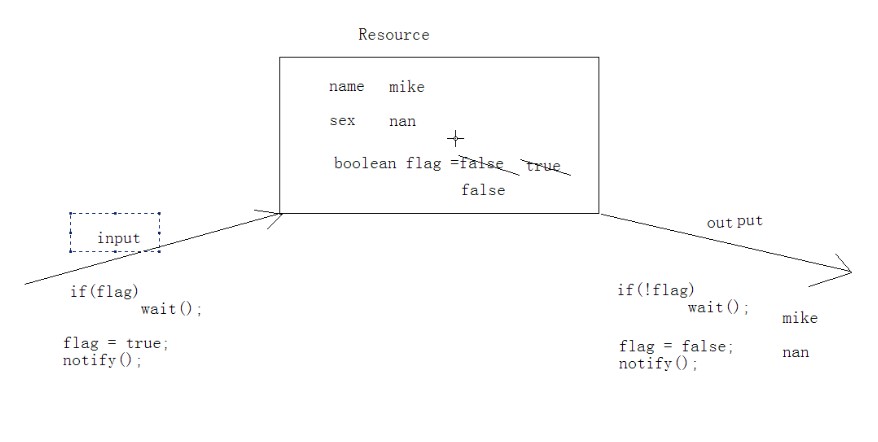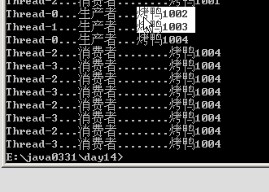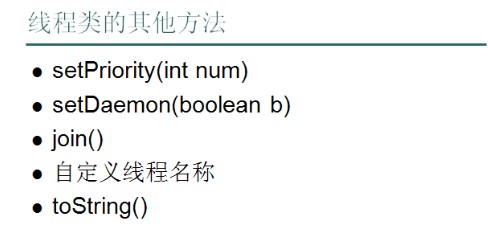等待唤醒机制:
涉及的方法:
1,wait();让线程处于冻结状态,被wait的线程会被存到线程池中。(线程池到底又是个什么东西!)
2,notify();唤醒线程池中一个线程(任意)。
3,notifyAll();唤醒线程池中全部线程。
这些方法都必须定义在同步中。(为什么?)
因为这些方法是用于操作线程状态的方法,必须要明确操作的是哪个锁上的线程。
wait();是用来操作线程的,但是居然不在线程类里面。为什么在Object里面?
为什么操作线程的方法wait(),notify(),notifyall定义在了object类里面?
原因是:因为这些是监视器的方法,监视器其实就是锁。而锁呢?可是是任意对象嘛,任意的对象调用的方式一定是定义在Object类中。
所谓的对象监视器-----就是锁
要求理解这个图。
唤醒机制练习:
/*
唤醒机制练习:
思想:
1,建立资源对象,资源对象有资源,就向外提供get 与 set 方法。
2,输入、输出资源方法,是对资源同时进行的方法,用到多线程,实现Runnable
*/
//建立资源对象
class Resource
{
private String name;
private String sex;
private boolean flag = false;//用于线程冻结与唤醒标志位
public synchronized void set(String name , String sex)//加锁因在线程里面
{
if(flag)//真就输入数据
try{this.wait();}catch (InterruptedException e){}
this.name = name;
this.sex = sex;
flag = true ;//改标志位,后唤醒
this.notify();
}
public synchronized void out()
{
if(!flag)
try{this.wait();}catch (InterruptedException e){}
System.out.println(name+"...+++++...."+sex);
flag = false;
this.notify();
}
//建立输入对象
class Input implements Runnable
{
Resource r ;
Input(Resource r)
{
this.r = r;
}
public void run()
{
int x = 0;//取模判断用于切换模式
while(true)
{
if(x == 0)
{
r.set("张山....","男");
}
else
{
r.set("媛媛.......","女");
}
x = x++%2;
}
}
}
//描述输出对象
class Output implements Runnable
{
Resource r ;
Output(Resource r)
{
this.r = r;
}
public void run()
{
r.out();
}
}
}
class ResourceDemo
{
public static void main(String[] args)
{
//System.out.println("Hello World!");
// 创建资源
Resource r = new Resource();
// 创建任务
Input in = new Input(r);
Output out = new Output(r);
//创建线程
Thread t = new Thread(in);
Thread t1 = new Thread(out);
//开启线程
t.start();
t1.start();
}
}
来多生产者,多消费者实例:
线程安全隐患出现,一但出现线程安全隐患,考虑有没有共享数据。
/*
生产者,消费者。
多生产者,多消费者的问题。
if判断标记,只有一次,会导致不该运行的线程运行了。出现了数据错误的情况。
while判断标记,解决了线程获取执行权后,是否要运行!
notify:只能唤醒一个线程,如果本方唤醒了本方,没有意义。而且while判断标记+notify会导致死锁。
notifyAll解决了本方线程一定会唤醒对方线程的问题。
*/
class Resource
{
private String name;
private int count = 1;
private boolean flag = false;
public synchronized void set(String name)//
{
while(flag)
//if(flag) //导致线程错过消费的问题点if语句,冻结后继续往下执行,不再判断而导致的问题。
//重点了解if和while的区别
try{this.wait();}catch(InterruptedException e){}// t1 t0
this.name = name + count;//烤鸭1 烤鸭2 烤鸭3
count++;//2 3 4
System.out.println(Thread.currentThread().getName()+"...生产者..."+this.name);//生产烤鸭1 生产烤鸭2 生产烤鸭3
flag = true;
notifyAll();//为了能唤醒消费的线程。
//notify();
}
public synchronized void out()// t3
{
while(!flag)
//if(!flag)
try{this.wait();}catch(InterruptedException e){} //t2 t3
System.out.println(Thread.currentThread().getName()+"...消费者........"+this.name);//消费烤鸭1
flag = false;
notifyAll();
//notify();
}
}
class Producer implements Runnable
{
private Resource r;
Producer(Resource r)
{
this.r = r;
}
public void run()
{
while(true)
{
r.set("烤鸭");
}
}
}
class Consumer implements Runnable
{
private Resource r;
Consumer(Resource r)
{
this.r = r;
}
public void run()
{
while(true)
{
r.out();
}
}
}
class ProducerConsumerDemo
{
public static void main(String[] args)
{
Resource r = new Resource();
Producer pro = new Producer(r);
Consumer con = new Consumer(r);
Thread t0 = new Thread(pro);
Thread t1 = new Thread(pro);
Thread t2 = new Thread(con);
Thread t3 = new Thread(con);
t0.start();
t1.start();
t2.start();
t3.start();
}
}
多线程(线程间通信-多生产者多消费者问题-JDK1.5新特性-Lock)---------为了解决notifyAll ();

Condition接口中的方法有自己的实现方法!
以前痛苦的地方就是一个锁上只有一组监视器,这组监视器即监视着生产者又监视着消费者。(其实这里就是解决notifyAll();的方法)
现在考虑:现在可以生产者和消费者都具备一套监视器
问题:以前也可以弄啊?但是是生产者和消费者持有不同的锁才行。
实现方法:
API实例(要求能自己写):
class BoundedBuffer {
final Lock lock = new ReentrantLock();
final Condition notFull = lock.newCondition();
final Condition notEmpty = lock.newCondition();
final Object[] items = new Object[100];
int putptr, takeptr, count;
public void put(Object x) throws InterruptedException {
lock.lock();
try {
while (count == items.length)
notFull.await();
items[putptr] = x;
if (++putptr == items.length) putptr = 0;
++count;
notEmpty.signal();
} finally {
lock.unlock();
}
}
public Object take() throws InterruptedException {
lock.lock();
try {
while (count == 0)
notEmpty.await();
Object x = items[takeptr];
if (++takeptr == items.length) takeptr = 0;
--count;
notFull.signal();
return x;
} finally {
lock.unlock();
}
}
}
要求熟悉的例子:
/*
jdk1.5以后将同步和锁封装成了对象。
并将操作锁的隐式方式定义到了该对象中,
将隐式动作变成了显示动作。
Lock接口: 出现替代了同步代码块或者同步函数。将同步的隐式锁操作变成现实锁操作。
同时更为灵活。可以一个锁上加上多组监视器。
lock():获取锁。
unlock():释放锁,通常需要定义finally代码块中。
Condition接口:出现替代了Object中的wait notify notifyAll方法。
将这些监视器方法单独进行了封装,变成Condition监视器对象。
可以任意锁进行组合。
await();
signal();
signalAll();
*/
import java.util.concurrent.locks.*;
class Resource
{
private String name;
private int count = 1;
private boolean flag = false;
// 创建一个锁对象。
Lock lock = new ReentrantLock();
//通过已有的锁获取该锁上的监视器对象。
// Condition con = lock.newCondition();
//通过已有的锁获取两组监视器,一组监视生产者,一组监视消费者。
Condition producer_con = lock.newCondition();
Condition consumer_con = lock.newCondition();
public void set(String name)// t0 t1
{
lock.lock();
try
{
while(flag)
// try{lock.wait();}catch(InterruptedException e){}// t1 t0
try{producer_con.await();}catch(InterruptedException e){}// t1 t0
this.name = name + count;//烤鸭1 烤鸭2 烤鸭3
count++;//2 3 4
System.out.println(Thread.currentThread().getName()+"...生产者5.0..."+this.name);//生产烤鸭1 生产烤鸭2 生产烤鸭3
flag = true;
// notifyAll();
// con.signalAll();
consumer_con.signal();
}
finally
{
lock.unlock();
}
}
public void out()// t2 t3
{
lock.lock();
try
{
while(!flag)
// try{this.wait();}catch(InterruptedException e){} //t2 t3
try{cousumer_con.await();}catch(InterruptedException e){} //t2 t3
System.out.println(Thread.currentThread().getName()+"...消费者.5.0......."+this.name);//消费烤鸭1
flag = false;
// notifyAll();
// con.signalAll();
producer_con.signal();
}
finally
{
lock.unlock();
}
}
}
class Producer implements Runnable
{
private Resource r;
Producer(Resource r)
{
this.r = r;
}
public void run()
{
while(true)
{
r.set("烤鸭");
}
}
}
class Consumer implements Runnable
{
private Resource r;
Consumer(Resource r)
{
this.r = r;
}
public void run()
{
while(true)
{
r.out();
}
}
}
class ProducerConsumerDemo2
{
public static void main(String[] args)
{
Resource r = new Resource();
Producer pro = new Producer(r);
Consumer con = new Consumer(r);
Thread t0 = new Thread(pro);
Thread t1 = new Thread(pro);
Thread t2 = new Thread(con);
Thread t3 = new Thread(con);
t0.start();
t1.start();
t2.start();
t3.start();
}
}
wait(); 和sleep();的区别?
1,wait(); 可以指定时间也可以不指定。(也就是说wait可以是无休止的)
sleep必须指定时间。
2,在同步中时,对cpu的执行权和锁的处理不同。
wait();释放执行权,释放锁
sleep();释放执行权,不释放锁。(这不需要人叫,自己可以醒)
线程什么时候消亡呢?
停止线程方式一:定义标记(有解决不了的问题的时候,是什么呢?)
答案:如果线程处于冻结状态,就不会有机会判断标志位了。那又怎么结束呢?
停止线程:
1,stop方法。
2,run方法结束。
怎么控制线程的任务结束呢?
任务中都会有循环结构,只要控制住循环就可以结束任务。
控制循环通常就用定义标记来完成。(标志位控制)
但是如果线程处于了冻结状态,无法读取标记。如何结束呢?
可以使用interrupt()方法将线程从冻结状态强制恢复到运行状态中来,让线程具备cpu的执行资格。
(恢复到运行状态后再结束线程,就会安全)
当时强制动作会发生了InterruptedException,记得要处理

多线程总结:
1,进程和线程的概念。
|--进程:
|--线程:
2,jvm中的多线程体现。
|--主线程,垃圾回收线程,自定义线程。以及他们运行的代码的位置。
3,什么时候使用多线程,多线程的好处是什么?创建线程的目的?
|--当需要多部分代码同时执行的时候,可以使用。
4,创建线程的两种方式。★★★★★
|--继承Thread
|--步骤
|--实现Runnable
|--步骤
|--两种方式的区别?
5,线程的5种状态。
对于执行资格和执行权在状态中的具体特点。
|--被创建:
|--运行:
|--冻结:
|--临时阻塞:
|--消亡:
6,线程的安全问题。★★★★★
|--安全问题的原因:
|--解决的思想:
|--解决的体现:synchronized
|--同步的前提:但是加上同步还出现安全问题,就需要用前提来思考。
|--同步的两种表现方法和区别:
|--同步的好处和弊端:
|--单例的懒汉式。
|--死锁。
7,线程间的通信。等待/唤醒机制。
|--概念:多个线程,不同任务,处理同一资源。
|--等待唤醒机制。使用了锁上的 wait notify notifyAll. ★★★★★
|--生产者/消费者的问题。并多生产和多消费的问题。 while判断标记。用notifyAll唤醒对方。 ★★★★★
|--JDK1.5以后出现了更好的方案,★★★
Lock接口替代了synchronized
Condition接口替代了Object中的监视方法,并将监视器方法封装成了Condition
和以前不同的是,以前一个锁上只能有一组监视器方法。现在,一个Lock锁上可以多组监视器方法对象。
可以实现一组负责生产者,一组负责消费者。
|--wait和sleep的区别。★★★★★
8,停止线程的方式。
|--原理:
|--表现:--中断。
9,线程常见的一些方法。
|--setDaemon()
|--join();
|--优先级
|--yield();
|--在开发时,可以使用匿名内部类来完成局部的路径开辟。






























 554
554

 被折叠的 条评论
为什么被折叠?
被折叠的 条评论
为什么被折叠?








